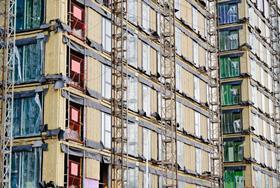
MPs sceptical government can deliver on building safety remediation promises
www.bdonline.co.uk
Timetable to complete work on buildings over 18m set for 2029The governments plan to remediate unsafe buildings across the UK are both insufficiently ambitious and at risk of not delivering what it promises, according to a parliamentary committee.At the end of last year, the new Labour government published its plan for addressing the building safety crisis that followed the Grenfell Tower tragedy of 2017, in which 72 people were killed.Source: MHCLG / FlickrHousing minister Angela Rayner, pictured chairing a roundtable on housing safetyThe plan set a target to complete remediation on all buildings taller than 18m by 2029, 12 years after the deadly blaze, along with an ambition to establish a completion date for all buildings taller than 11m by the same deadline.But in a report published on Friday, the public accounts committee, parliaments watchdog committee for public spending, said it shared the concerns of campaigners that the plan, which relies on new legislation, will not achieve what it promises.Committee chair Geoffrey Clifton-Brown MP, a chartered surveyor, said he had been utterly appalled by evidence given to the inquiry, which showed residents still mired in the cladding crisis with no immediate solutions at hand.It would have course been the committees wish that this report carried better news for all affected, he said.Unfortunately, we are united with campaigners in deeply regrettable scepticism that current remediation plans are capable of delivering on whats promised.The PAC alleges that, eight years on from Grenfell, the government still does not know how many buildings have dangerous cladding, how much it will cost to address, or how long it will take.Up to 7,000 unsafe buildings have yet to be identified, according to the committee, and it said the government had yet to find a way to secure financial contributions from manufacturers of dangerous cladding.It also accused the government of being complacent about risks to its plans, including insufficient capacity and skills across regulators, local authorities and the construction sector.The report said the government was not taking seriously enough the risk that social housing providers would move scarce resources away from building new housing in order to meet their remediation commitments. It asked for a formal impact assessment on this issue by the end of the year.PACs recommendations for the Ministry for Housing, Communities and Local Government include that it should:Within six months, provide the Committee with an update clearly setting out how it will address gaps between the Remediation Acceleration Plan and the policy and legislative changes needed to deliver them, as well as what it is doing to ensure that non-cladding defects are not holding up progress on cladding remediationBy the end of July 2025, write to the PAC setting out its plan to ensure sufficient capacity across the remediation systemWrite to the committee with an update on how effectively it is putting residents at the heart of its remediation effortsUndertake a review of insurance premiums and consider what more it can doPublish its latest estimates for how many buildings are affected by dangerous cladding, and when it expects work to be completed, by the end of July 2025Bring forward detailed proposals for making manufacturers pay for a share of remediation costs by the end of 2025Indicate when it will respond to the Morrell report on product testing and safetyStrengthen anti-fraud controls by the end of the yearBy the end of the year, publish a formal assessment of its remediation policies, including the Building Safety Levy, on housebuildingEvidence to the inquiry found many people still felt trapped in unsafe homes they were unable to sell, with residents in affected buildings facing exorbitant insurance premiums.It also showed that disputes over safety were delaying starts to work, with a promised formal dispute resolution process yet to have materialised.The committee asked the government to consider what could be done to bring down premiums for residents waiting for work to start.According to the PAC, as many as three million people may have been affected by the building safety crisis.Eight years after Grenfell, it is still not known how many buildings out there have dangerous cladding, and when it will be removed. That vow remains unkept for every day that is still the case.The committee chair urged the government to look at the recommendations made in its report in order to close the gap between their current plans, and the reality on the ground.The report also found that 500,000 had been lost to suspected fraud after protections were relaxed to get money out quickly through the Building Safety Fund. It recommended that counter-fraud controls be strengthened.
0 Commentaires
·0 Parts
·124 Vue


